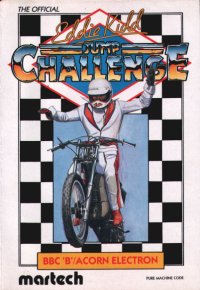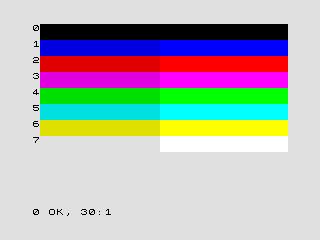The Sinclair QL is a personal computer launched by Sinclair Research in 1984, as an upper-end counterpart to the ZX Spectrum.

The Sinclair ZX80 is a home computer launched on 29 January 1980 by Science of Cambridge Ltd.. It is notable for being one of the first computers available in the United Kingdom for less than a hundred pounds. It was available in kit form for £79.95, where purchasers had to assemble and solder it together, and as a ready-built version at £99.95.

The ZX Spectrum is an 8-bit home computer developed and marketed by Sinclair Research. It was first released in the United Kingdom on 23 April 1982. Many official and unofficial clones were released around the world in the following years, most notably in Europe, the United States, and Eastern Bloc countries.

Interlaced video is a technique for doubling the perceived frame rate of a video display without consuming extra bandwidth. The interlaced signal contains two fields of a video frame captured consecutively. This enhances motion perception to the viewer, and reduces flicker by taking advantage of the phi phenomenon.

The SAM Coupé is an 8-bit British home computer manufactured by Miles Gordon Technology (MGT), based in Swansea in the United Kingdom and released in December 1989.

D-1 or 4:2:2 Component Digital is an SMPTE digital recording video standard, introduced in 1986 through efforts by SMPTE engineering committees. It started as a Sony and Bosch - BTS product and was the first major professional digital video format. SMPTE standardized the format within ITU-R 601, also known as Rec. 601, which was derived from SMPTE 125M and EBU 3246-E standards.
Sinclair BASIC is a dialect of the programming language BASIC used in the 8-bit home computers from Sinclair Research, Timex Sinclair and Amstrad. The Sinclair BASIC interpreter was written by Nine Tiles Networks Ltd.
The Didaktik was a series of 8-bit home computers based on the clones of Intel 8080 and Zilog Z80 processors produced by Didaktik in Skalica, in the former Czechoslovakia.

3D Monster Maze is a survival horror computer game developed from an idea by J.K. Greye and programmed by Malcolm Evans and released in 1981 for the Sinclair ZX81 platform with the 16 KB memory expansion. The game was initially released by J. K. Greye Software in December 1981 and re-released in 1982 by Evans' own startup, New Generation Software. Rendered using low-resolution character block "graphics", it was one of the first 3D games for a home computer, and one of the first games incorporating typical elements of the genre that would later be termed survival horror.

Hold-And-Modify, usually abbreviated as HAM, is a display mode of the Commodore Amiga computer. It uses a highly unusual technique to express the color of pixels, allowing many more colors to appear on screen than would otherwise be possible. HAM mode was commonly used to display digitized photographs or video frames, bitmap art and occasionally animation. At the time of the Amiga's launch in 1985, this near-photorealistic display was unprecedented for a home computer and it was widely used to demonstrate the Amiga's graphical capability. However, HAM has significant technical limitations which prevent it from being used as a general purpose display mode.

Target: Renegade is a scrolling beat'em up computer game released on the Amstrad CPC, Commodore 64 and ZX Spectrum systems in the late 1980s by Ocean Software on their "Imagine" label, as well as a Nintendo Entertainment System version published by Taito. The game is a sequel to Renegade and was followed by Renegade III: The Final Chapter. When acquiring the license to convert the original arcade game Renegade to home computers, Ocean acquired the option to produce and release their own home-computer-only sequels to the game, and Target Renegade was the first of these sequels.

Eddie Kidd Jump Challenge is a stunt bike video game released for the Acorn Electron, BBC Micro, Commodore 64, MSX and ZX Spectrum first released in 1984, licensed by British stunt performer, Eddie Kidd.

The original ZX Spectrum computer outputs video through an RF modulator and was designed for use with contemporary 1980s television sets, for a simple colour graphic display.

Book scanning or book digitization is the process of converting physical books and magazines into digital media such as images, electronic text, or electronic books (e-books) by using an image scanner. Large scale book scanning projects have made many books available online.
The ZX Spectrum's software library was very diverse. While the majority of the software produced for the system was video games, others included programming language implementations, Sinclair BASIC extensions, databases, word processors, spread sheets, drawing and painting tools, and 3D modelling tools.
The ColecoVision, SG-1000, CreatiVision, and first-generation MSX computers use the TMS9918A Video Display processor (VDP), which has its own 16 KiB of video memory that was not shared with main memory. Compared to the unified system and video memory used by other 8-bit computers of the time, such as the Apple II, ZX Spectrum, and Commodore 64, separate memory has the advantage of freeing up of the Z80 processor's 64 KiB address space for main RAM, and the VDP does not need to steal CPU cycles to access video memory. The disadvantage is that the program has to use the CPU's dedicated I/O instructions to command the VDP to manipulate the contents of the video RAM. This not only slows down video access but also makes the porting of games from unified-memory platforms more difficult. Attempts of porting ZX Spectrum games were often thwarted by this difference. Also, programmers had to learn to optimally use the more advanced capabilities of the VDP.

A loading screen is a screen shown by a computer program, very often a video game, while the program is loading or initializing.

Romantic Robot is a small independent British company that publishes classical music recordings. In the 1980s it designed and produced peripherals and software for home computers.

The Orion-128 is a DIY computer designed in Soviet Union. It was featured in the Radio magazine in 1990, other materials for the computer were published until 1996. It was the last Intel 8080-based DIY computer in Russia.













